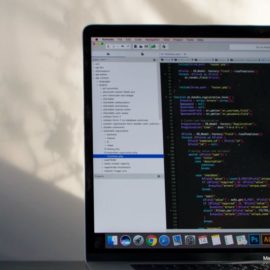

This article is an excerpt from the Shortform book guide to "Thank You for Being Late" by Thomas L. Friedman. Shortform has the world's best summaries and analyses of books you should be reading.
Like this article? Sign up for a free trial here .
What are the main challenges with the current state of U.S. domestic politics? How can the U.S. adapt its systems to keep up with the times?
According to Thomas Friedman, the author of Thank You for Being Late, U.S. domestic politics is currently experiencing political upheaval because the present political system was developed in slower times. As a result, it can’t keep up with the three accelerations taking place in the world: 1) technology, 2) climate change, and 3) globalization.
In this article, we’ll discuss the current state of American domestic politics and what we could do to make it more functional in light of the three accelerations.
History of Domestic Politics and Culture
In the 20th century, the U.S. political system centralized and nationalized political power and directed it towards big problems such as social programs. This was logical in the 20th century because smaller governments weren’t very powerful—certain individuals had more money than states and municipalities.
Federal power was further consolidated in the 21st century. The Great Depression’s New Deal created national programs such as Social Security, and in World War II, even more responsibility shifted from smaller levels of government to the federal government as it tackled issues such as urban decay and pollution. Then, the Cold War created more federal responsibility.
All of the above events contributed to the maintenance of the two-party federal system. The Republicans oppose immigration, want to relax the rules on the market, and want to cut taxes, while the Democrats support social programs and regulations.
After the massive technological changes in 2007, the 2008 recession hit and politics stalled because leaders couldn’t explain the situation to citizens and failed to implement policy changes, such as technology regulations, that would have helped people adapt. This left space for populists who promised to hold back changes.
Current State of Domestic Politics and Culture
The US is currently experiencing political upheaval because the current political system was developed in slower times and can’t keep up with the three accelerations. The two parties are too committed to their identities (and too reliant on their funders) to consider ideas that don’t fit neatly into their platforms, and as a result, they’re limiting the country’s ability to adapt because they won’t consider compromising or starting from scratch. For example, some members of the Republication Party deny that one of the accelerations, climate change, is even happening.
Adapting
In these accelerating times, we need to rethink U.S. domestic politics and culture by: 1) studying Mother Nature, which is one of the most adaptable and resilient systems on the planet, and 2) applying nature’s adaptations to domestic politics and culture.
Learning From Mother Nature
Mother Nature has enormous buffering capacities and many people, including the author, have looked to it for an example of how to handle accelerating change. To maintain dynamic stability, Mother Nature uses the following mechanisms:
Mechanism #1: Adaptability. Evolution is fueled by adaptation—the organisms that have biological advantages, or that can figure out a behavioral advantage, find enough resources to survive long enough to reproduce. The organisms that don’t adapt, or don’t adapt well enough to compete with other organisms, die.
- Example of a genetic adaptation: The Namib desert beetle lives in an environment that sees only 1.3cm of rain a year. To get enough water to survive, the beetle collects condensation from the air on its shell, which is covered in bumps that attract water.
- Example of a behavioral adaptation: Ant colonies assign their populations different jobs, for example, some ants babysit, giving other ants the freedom to look for food across a wider area.
Mechanism #2: Bankruptcy. If an organism can’t adapt fast enough, it dies off, which makes more resources available for stronger organisms.
Mechanism #3: Diversity. The more species there are in a particular area, the more resilient it is. This is because when there are many options, even if not every species can survive and adapt, at least some will be able to.
Mechanism #14: Ownership. Species all have a niche and habitat where they thrive, which you can think of them “owning.” When every organism is locked into its place, it’s hard for a single introduced species or pollutant to destroy the whole system.
Mechanism #5: Federalism. Nature is made up of many small networks that make up larger ecosystems that make up even larger ecosystems. Every organism is part of multiple networks, and the network of networks is stabilizing.
Mechanism #6: Entrepreneurship. If there’s an open niche, some organism will find a way to fill it. Additionally, organisms are always testing out if they can coevolve—if an experiment makes an ecosystem better, the change survives.
- For example, one type of loris (a primate) eats only the leaves at the tips of branches. Another type of loris eats the leaves closer to the tree trunk. The two lorises don’t compete with each other because they eat just slightly different things.
Mechanism #7: Interdependency. Interdependence can either be to the benefit of all parties or the detriment. Organisms in healthy interdependencies thrive.
- Example of a healthy interdependency: spider monkeys, woolly monkeys, and hardwood trees interact in a way that furthers the survival of all three species. The monkeys eat the fruit of the hardwood trees, including the seeds. The monkeys digest the fruits but excrete the seeds, distributing them around the forest. New trees grow from the seeds, and their fruit will feed the monkeys.
- Example of an unhealthy interdependency: Humans, monkeys, and trees interact in a way that harms all three species. Humans heavily hunt the monkeys, and once the monkeys are gone, there’s no longer a distributor of hardwood seeds. This results in fewer trees. Trees absorb carbon dioxide, so decreasing their numbers increases the amount of carbon dioxide in the air. This contributes to global warming, which is affecting the survival of humans.
Applying Mother Nature’s Mechanisms to Domestic Politics and Culture
Nature is brutal and a constant battle, so we can’t apply Mother Nature’s mechanisms exactly the way they act in nature, but five of them are particularly transferable to domestic politics and culture. The countries that choose to leverage these apps will be the most successful in riding the three accelerations.
Adaptation
Adaptation, in the context of domestic politics and culture, is the ability to learn from other cultures. As we’ve learned in previous chapters, in the age of accelerations, we encounter new cultures more than ever.
When a country, culture, or individual is presented with a country, culture, or individual that’s more successful in some way—economic, military, and so on—there are two possible responses: 1) try to learn from the more successful party, or 2) feel humiliated, blame the other party for deficiencies, and turn away.
The cultures that choose to learn from others will do a better job of weathering the accelerations. For example, in the 19th century, when Japan opened to trade with other countries, Japanese politicians realized that their country was behind the West. Japan decided it wanted to match the West, so the country overhauled its society. It took decades, but in 1905, Japan had become strong enough to defeat Russia in war.
Diversity
Diversity, in the context of domestic politics and culture, is having as wide a knowledge and talent pool as possible so that when there’s a problem, someone will have a solution. (Note that diversity isn’t simply about the existence of multiple groups within a population, it also requires the interaction of the multiple groups.)
The cultures that embrace diversity will do a better job of weathering the accelerations. For example, when the Arab-Muslim world was most diverse (between the eighth and 13th centuries), it was one of the most advanced societies of the time. This was because Islamic scholars considered the work and teachings of a variety of other cultures, which gave them new ideas they could build upon.
Ownership
In the context of domestic politics and culture, ownership is feeling responsible for a space. When people feel like they own their space, whether that’s their country or their education, the space is more resilient because people will take care of it and defend it from harm.
For example, in Independence Square in Kiev during the 2014 revolution, elderly women cleared the ice from the sidewalks so the protestors wouldn’t slip. They cared about the space, so they maintained it.
Federalism
In the context of domestic politics and culture, federalism is the assignment of responsibility between local, state, and federal governments. These three networks need to reevaluate their roles in order to weather the accelerations.
Today, the US federal government is hugely bureaucratic and too slow to keep up with the accelerations. State and local governments, on the other hand, have learned to react to change promptly. State and local governments are at the epicenters of the regions they’re responsible for, so they notice change quickly, and they’re well-equipped to address the change because: 1) new people with new knowledge now live in the US due to globalization, 2) they can access knowledge from anywhere because of the supernova, and 3) they can use all this knowledge to sponsor trade missions or reeducate their workforces.
The federal level of government is still necessary, but its major role should become supporting development at other levels of government.
Entrepreneurship
In the context of domestic politics and culture, entrepreneurship is looking for solutions anywhere, regardless of party lines.
According to the author, the lines aren’t between the left and right anymore, they’re between openness and closedness, and to adapt, we need to choose openness—openness to flows, the supernova, and innovation. He suggests we:
1. Create universal healthcare. This would simplify healthcare—US companies would no longer need to provide healthcare to their employees and Medicare wouldn’t be related to payroll. The steps include:
- Fund healthcare with a progressive value-added consumption tax and make it the responsibility of a single public system.
- Adjust the tax each year so that citizens can see that the tax is directly connected to the cost of healthcare.
2. Label high-sugar foods with warnings about health problems. Diabetes costs $825 billion a year globally and global diabetes has been rising since 1980.
3. Improve free trade. Free trade benefits the general public because it makes goods cheaper, but it also creates job loss. The steps to improving free trade include:
- Support the free trade agreements between the US and the EU, and the US and Pacific Rim countries.
- Support wage insurance for workers whose livelihood is negatively impacted by the free trade agreements. The wage insurance program should be temporary and incentivize finding new jobs.
4. Reform immigration. The steps include:
- Increase security along the US-Mexico border by building fences or monitoring the line digitally. It’s important that Americans feel like their country’s borders are controlled.
- Control low-skilled immigration so incoming workers don’t take jobs from Americans.
- Make it easier for high-skilled workers to immigrate.
- Increase research funding for national health organizations and labs, which will create new jobs and attract international workers.
5. Reform foreign aid by making aid conditional—foreign countries only receive it if they commit to working towards gender equality and making family planning available to those who want it.
6. Improve infrastructure. Today’s interest rates are low, so it’s a good time to borrow $50 billion and put it towards grids, airports, and ports. This will also create jobs.
7. Improve postsecondary education. The steps include:
- Make all postsecondary education tax-deductible. This will have two benefits: 1) make it possible for everyone to engage in affordable lifelong learning, and 2) create more teaching jobs.
- Use Common Core as the national educational standard and give teachers the resources to retrain and buy supplies.
- Reduce the time it takes to get an undergraduate degree to three years. This would make it 25% cheaper to get a degree. Plenty of international universities already offer three-year degrees, so it’s definitely possible to get a full education in a shorter time period.
8. Open a “race to the top” contest between states with million-dollar prizes to encourage innovation in social technologies. For example, the contest might be to come up with the best way to retain workers.
9. Improve internet connectivity. Studies show that Internet access is directly related to economic growth. The steps to improving connectivity include:
- Create tax incentives.
- Remove regulatory barriers.
10. Strengthen gun control. Australia’s gun control methods are effective and we should implement them too:
- Ban the making and sale of military-style guns such as semi-automatics.
- Buy back pistols and rifles from the population.
11. Improve national security. The steps include:
- Give intelligence services the resources they need to counter today’s technological threats such as cyberterrorists. (But keep monitoring them.)
- Raise the Peace Corps to the same level of service as the Army and open a service academy. The Peace Corps would work in neighborhoods and villages in foreign countries to help keep order and prevent mass migration to the US.
12. Reform the tax system to incentivize desirable behavior and discourage undesirable behavior. These reforms will provide the funding for other points on this list. The steps include:
- Cut America’s corporate income tax. This would have the following benefits:
- Accountants and lobbyists would stop wasting time trying to take advantage of the current system.
- Companies would increase their profits, which would benefit the economy, and the government would make more money from personal income tax.
- Stock prices would increase, which would increase everyone’s 401(k)s, which would encourage people to spend more.
- Nonprofit companies would no longer have to prove their status to receive tax benefits.
- Money that people keep in foreign countries to avoid having to pay the tax would return to the US.
- Foreign companies would be attracted to the US because it would have the lowest corporate tax rates in the world.
- Adjust Social Security inflation calculations. Cost-of-living increases are making the program grow so quickly that it may not be sustainable for future generations.
- Introduce a carbon tax, tax on bullets, and tax on financial trades. Low-income workers would receive a credit on these taxes.
- Tax dividend income and capital gains at the same rate as income.
13. Improve the Earned Income Tax Credit and Child Tax Credit. These credits top up the income of low-income workers so that they don’t fall into poverty, but also encourage people to work because they can make more money from their jobs than they would receive from the credit. Recent research found that the EITC is more beneficial for children’s education than early childhood programs such as Head Start or prekindergarten.
14. Streamline laws and regulations. The steps include:
- Put together a Regulatory Improvement Commission to look through federal regulations and improve or remove them. There are more regulations than ever and keeping track of them all is expensive for businesses and hurts economic growth.
- The commission would give Congress a list of 15-20 changes and Congress could approve or vote down the list as a whole.
15. Reform bankruptcy laws and encourage entrepreneurship. The steps include:
- Roll back the changes to bankruptcy laws that went into effect in 2005. These changes made it more expensive to declare bankruptcy and harder to start a new business after bankruptcy. A USC study found that these changes discouraged entrepreneurs from starting businesses.
- Hire an independent commission to take a look at the Sarbanes-Oxley regulations and Dodd-Frank financial reforms to ensure that neither of these is making it too difficult to start businesses or raise capital.
16. Adjust national political campaigning. The steps include:
- Create a limit on spending.
- Limit the length of campaigning—currently, so much time is spent campaigning that it’s getting in the way of the government’s ability to function.
17. Implement electoral reform. The steps include:
- End gerrymandering (redrawing the borders of congressional districts by politicians) by asking a group of nonpartisan, retired jurists to draw the borders in a balanced way. This will make elections more competitive because there are no safe seats.
- Move to a ranked-choice voting system in House and Senate elections. In this system, instead of voting for one candidate, you rank your choices in order of preference. If no candidate wins a majority, the least popular candidate is eliminated. The vote of anyone who ranked her first is transferred to their second choice. This allows people to vote for whoever they want without feeling like they’re wasting their vote on someone who will never win.
- Remove the sore-loser ban. The sore-loser ban prevents people who lose their party’s primary from running in the general election. Currently, this ban is creating a system in which someone moderate who the general public would have supported is cut out of the running early. This leaves the public with only more extreme candidates.

———End of Preview———
Like what you just read? Read the rest of the world's best book summary and analysis of Thomas L. Friedman's "Thank You for Being Late" at Shortform .
Here's what you'll find in our full Thank You for Being Late summary :
- The problems that arise when the world changes faster than humanity can adapt
- How to adapt to technology, globalization, and climate change
- The importance of taking time to reflect and reorient






